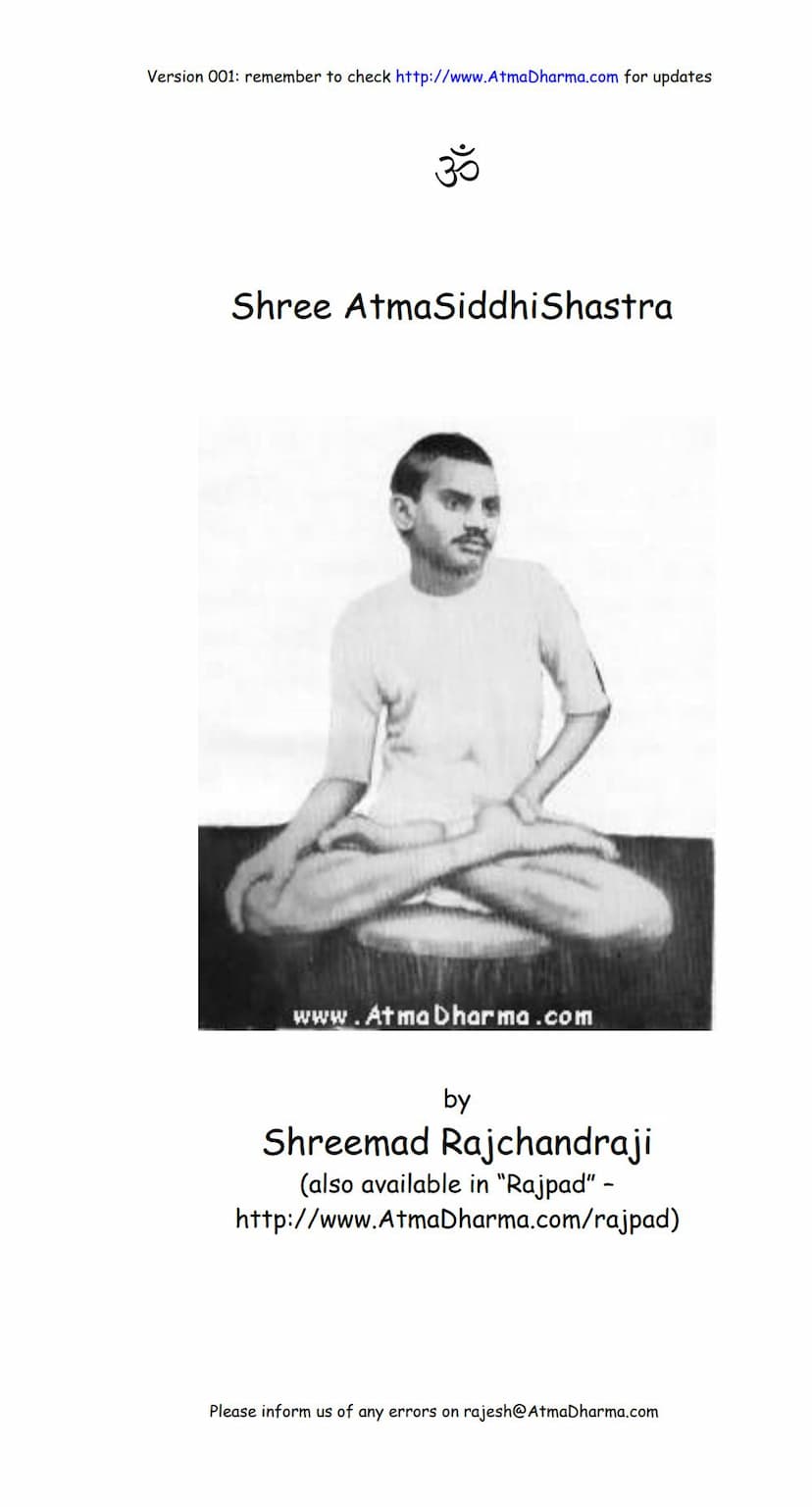Atmasiddhi Shastra
Added to library: September 1, 2025

Summary
Here's a comprehensive summary of the Atmasiddhi Shastra by Shrimad Rajchandra, based on the provided Gujarati text:
The Atmasiddhi Shastra (Science of Self-Realization) by Shrimad Rajchandra is a profound spiritual text that aims to guide the seeker towards liberation (moksha) by clarifying the true nature of the soul and the path to its realization. The text emphasizes the importance of a true Guru and the necessity of understanding the core principles of Jain philosophy.
The scripture begins by lamenting the loss of the true path to moksha in the current era, observing that people are either engrossed in mere ritualistic actions (kriyajad) without inner understanding or stuck in dry intellectualism (shushk gyan) detached from true experience. The author expresses compassion for those who mistake these superficial approaches for the path to moksha.
Key Themes and Teachings:
- The Supremacy of Self-Knowledge (Atma Gyan): The text asserts that virtues like detachment (vairagya) and renunciation (tyag) are only fruitful when supported by self-knowledge. Conversely, self-knowledge is also dependent on the realization of these virtues. Without inner feeling, knowledge remains incomplete.
- The Indispensable Role of a True Guru (Sadguru): The scripture strongly advocates for the guidance of a living, enlightened Guru. While the teachings of the Tirthankaras (Jinas) are invaluable, direct guidance from a contemporary Guru is essential for true self-inquiry and understanding. The Guru acts as a guide to the Jina's teachings, making them accessible and understandable.
- Avoiding Dogmatism and Self-Will (Svachchhand): The text criticizes adherence to personal opinions and self-will, especially when it leads away from the Guru's path. True liberation is achieved by curbing self-will, not by indulging it.
- Identifying the "Opinionated Seeker" (Matarthi): A significant portion of the text is dedicated to delineating the characteristics of those who are merely followers of an opinion or sect (matarthi). These individuals often:
- Focus on external rituals and practices without inner understanding.
- Develop attachment to their lineage, traditions, or outward appearances.
- Interpret scriptures literally without deeper insight, often clinging to their own intellect.
- Mistake superficial knowledge or vows for true spiritual attainment.
- Are driven by ego, the desire for recognition, or pride in their chosen path.
- Lack true equanimity, detachment, and compassion.
- Identifying the "Self-Focused Seeker" (Atmarthi): In contrast, the true seeker (atmarthi) is characterized by:
- An unwavering focus on self-knowledge and the soul.
- Recognizing the profound importance of a living Guru.
- Living in accordance with the Guru's teachings and the principles of the soul.
- Possessing inner peace, a yearning for moksha, regret for worldly transgressions, and compassion for all beings.
- A clear understanding of the path to moksha, cultivated through reflection on the Guru's teachings.
- The Six-Pointed Doctrine (Shatpad): The core of the teachings is presented through a dialogue between a disciple and the Guru, addressing six fundamental truths about the soul:
- The Soul Exists: The disciple questions the existence of the soul as it is not perceived by the senses.
- The Soul is Eternal: The disciple raises doubts about the soul's permanence, citing the transient nature of things.
- The Soul is the Creator of its Actions: The disciple questions whether the soul truly creates actions or if it's nature or external forces.
- The Soul is the Experiencer of its Actions: The disciple probes who experiences the results of karma.
- Moksha Exists: The disciple questions the possibility of liberation.
- The Path to Moksha is Righteousness: The disciple seeks clarity on the correct path to liberation.
- Resolving the Doubts: The Guru meticulously addresses each of the disciple's doubts, explaining:
- The soul is distinct from the body and senses, recognized through the experience of awareness.
- The soul is eternal, though its modes (paryayas) change; it is not created or destroyed by conjunctions.
- The soul is the true doer and experiencer of karma, driven by its own will and consciousness.
- Moksha is the ultimate state of liberation from karma and worldly existence, attainable by eradicating ignorance, attachment, and aversion.
- The path to moksha involves the destruction of the root causes of karmic bondage, particularly Mohaniya karma (delusion-inducing karma), through wisdom, equanimity, and right conduct.
- The Nature of Moksha: Moksha is described as the state of pure consciousness, free from all worldly limitations and suffering, characterized by infinite knowledge, perception, bliss, and energy. It is the soul's inherent nature.
- The Importance of Both Naya (Viewpoints): The text emphasizes the need to understand both the ultimate reality (Nishchay Naya) and the conventional reality (Vyavahar Naya) without falling into one-sided interpretations. True spiritual progress involves the integrated practice of both.
- The True Signs of a Jñānī (Enlightened One): An enlightened person experiences the world as unreal or dream-like. Their actions are free from attachment and aversion, and they possess qualities like compassion, peace, equanimity, forgiveness, truth, renunciation, and detachment. The destruction of Moha (delusion) is a key indicator of true knowledge.
- The Goal: The ultimate goal is to realize the soul as it is – pure, conscious, blissful, and eternal – thereby achieving the state of liberation. The scripture concludes with the disciple's profound realization and gratitude to the Guru for illuminating the path.
In essence, the Atmasiddhi Shastra is a guide for the sincere seeker to transcend worldly illusions and ego, understand the true nature of the self, and attain the ultimate state of liberation through the grace of a Guru and the diligent practice of spiritual principles.